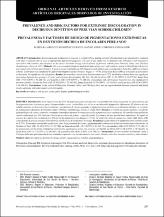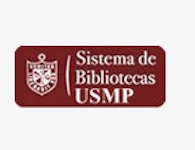Prevalence and risk factors for extrinsic discoloration in deciduous dentition of peruvian schoolchildren

Ver/
Trabajo
(application/pdf: 428.7Kb)
(application/pdf: 428.7Kb)
Fecha
2018-05-17Autor(es)
Chumpitaz Durand, Ruben Balabonce
Córdova Sotomayor, Daniel Angel
Metadatos
Mostrar el registro completo del ítemResumen
Introduction: discoloration due to fluorosis is frequent in northern Peru, making extrinsic discoloration to go unnoticed or confused with other conditions due to lack of appropriate differential diagnosis. The aim of this study was to determine the prevalence and risk factors associated with extrinsic discoloration in deciduous dentition among schoolchildren of primary schools from Pimentel, Salas, and Chiclayo (Lambayeque, Peru) in 2015. Methods: This was an epidemiological analytical study using cases and controls, aimed at identifying risk factors associated with extrinsic discoloration. It used a census population of 238 clinical records of first and second graders from three different primary schools. Calibration was conducted by differential diagnosis of discoloration (kappa k = 0.76), using Odds Ratio (OR) as a measure of association to determine the significance of risk factors. Results: The prevalence of extrinsic discolorations was 6.72%. In all three schools there was significant association between low presence of caries and extrinsic discoloration, like this: Nicolás La Torre (OR: 23.46 CI95% 2.53-217.96), Santa Rosa (OR: 19.33 CI 95% 1.81-206.73), and Lanchaco (OR:16.88 CI95% 1.71-166.21). The association with chromogenic bacteria was also significant in the three schools: Nicolás La Torre (OR:15.56 CI95% 1.70-142.05), Santa Rosa (OR:13.75 CI95% 1.31-143.85), and Lanchaco (OR:10.91 CI95% 1.14-104.81). Conclusions: in the schoolchildren from Pimentel, Salas, and Chiclayo there was an approximation between expected and found results, agreeing with other studies and antecedents.
Colecciones
- Artículos [274]
Editor
Universidad de Antioquia
Acceso
info:eu-repo/semantics/openAccess
Notas
Introducción: en la región norte de Perú, las pigmentaciones por fluorosis se presentan con cierta frecuencia, lo cual ocasiona que las pigmentaciones extrínsecas pasen desapercibidas o sean confundidas por no hacer un adecuado diagnóstico diferencial. El objetivo de este estudio consistió en determinar la prevalencia y los factores de riesgo asociados a pigmentaciones extrínsecas en dentición decidua en escolares de instituciones educativas de Pimentel, Salas y Chiclayo (Lambayeque, Perú), en el año 2015. Métodos: se realizó un estudio analítico, con diseño epidemiológico de casos y controles, orientado a identificar factores de riesgo asociados a pigmentaciones extrínsecas. Se consideró una población censal conformada por 238 historias clínicas de escolares de primer y segundo grado de primaria de tres instituciones educativas. Se siguió un proceso de calibración en diagnóstico diferencial de pigmentaciones (kappa k = 0,76). Se utilizó la razón de momio (en inglés Odds Ratio, OR) como medida de asociación para determinar la significancia de los factores de riesgo. Resultados: la prevalencia de pigmentaciones extrínsecas fue de 6,72%. Se encontró asociación significativa entre baja presencia de caries y pigmentaciones extrínsecas en las tres instituciones educativas, en Nicolás La Torre (OR: 23,46 IC95% 2,53-217,96), en Santa Rosa (OR: 19,33 IC95% 1,81-206,73) y en Lanchaco (OR:16,88 IC95% 1,71-166,21). La asociación con bacterias cromógenas también fue significativa en las tres escuelas, en Nicolás La Torre (OR:15,56 IC95% 1,70-142,05), en Santa Rosa (OR:13,75 IC95% 1,31-143,85) y en Lanchaco (OR:10,91 IC95% 1,14-104,81). Conclusiones: en los escolares de Pimentel, Salas y Chiclayo hubo una aproximación de los resultados esperados con los encontrados, los cuales además coinciden con otros estudios y antecedentes.







